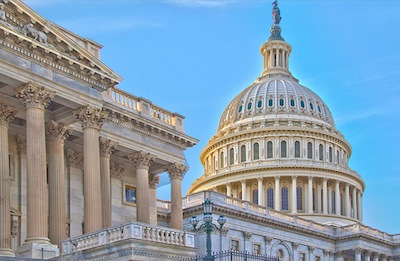
If a rowboat springs a leak and is fast filling with water, the first step is to stop the leak. Then the water can be baled out. A similar approach is necessary with America’s economy. For a very long time, excessive spending (the leak) has caused mounting national debt (the rising water that threatens to sink us). The first step in recovery is therefore to curtail government spending.
The problem is that people associated with government tend to oppose such curtailment. Elected officials see profligate spending as enhancing their status. Appointed bureaucrats and their union representatives see it as protecting their jobs. Recipients of government largesse feel entitled to what they receive and disinclined to criticize the system that provides it.
Such opposition to spending restraint explains why even recommendations to trim the rate of budgetary increase are denounced as radical ideas that will throw those in need under the bus, off the cliff, or under the bus and then off the cliff!
Recommendations to cut waste and inefficiency don’t fare any better. It’s not that bureaucrats are opposed to the idea in theory. In fact, they may even support it, as long as the cuts occur in someone else’s department or agency. (Their own operations, they tell themselves, operate at peak efficiency.)
With our deficit and debt at crisis levels, we desperately need a bold and comprehensive streamlining of government that includes:
- Eliminating federal agencies whose functions can be more efficiently and effectively performed by the individual states.
- Eliminating federal or state agencies that no longer solve the problems they were designed to solve or that create more problems than they solve.
- Combining agencies whose functions overlap.
- Requiring all federal and state agencies to adopt a standard cost plan and all agency directors to monitor productivity. (Such a plan matches work assignments to pay grades, promotes efficient work methods, and monitors individual and departmental productivity. Where variances from expected costs occur, they are analyzed and the underlying causes are identified and corrected.)
But however much we need comprehensive reform, given the current political climate we are unlikely to get it in a reasonable timeframe. Congress will feel it necessary to form one or more exploratory commissions and a lengthy investigatory process will ensue, followed by hearings and debates. Meanwhile, each elected official will work diligently to preserve his or her favorite agencies and pet projects. Years will pass and the country will fall trillions of dollars deeper in debt.
Clearly, we don’t have that kind of time. Our survival as a country, it is becoming clearer, depends on prompt action to rein in government spending. The question, then, is how can we move toward fiscal sanity immediately and, at the same time, buy the time necessary to undertake the more ambitious initiative?
The answer is simple: the next administration should pressure Congress for an immediate ten percent cut in the federal workforce. This would not involve a cut in benefits to citizens but only a cut in the personnel that administer benefits or perform other federal tasks.
The ten percent figure is not unreasonable. Although I have not been an industrial engineer for some years and the field has changed somewhat over time, the fundamental insights remain the same. A central one is that installing a standard cost plan in an operation that lacks one will initially produce at least a ten percent cost saving. This is accomplished, among other ways, by ensuring that higher paid employees do not spend their time doing work that can be done by lower paid employees, having employees adopt more efficient work habits, and ending unnecessary tasks.
Consider this example of a costly unnecessary task from my engineering experience. Clerks in eight different departments were devoting time each day to compiling certain information and submitting it to the accounting department for forwarding to the home office. When my engineering associate questioned whether the report was necessary, the chief accountant berated him, shouting that the report was absolutely essential and no meddling engineer had any business questioning it. Fortunately, my associate ignored the tirade, analyzed the matter further, and learned that almost a year earlier the home office has discontinued the report. However, no one had told the clerks, so they had wasted hundreds of hours compiling data that ended in the trash.
The value of a standard cost plan is based on the observable fact that where efficiency is not deliberately and conscientiously pursued, inefficiency reigns. Nowhere is this fact more evident than in government, where redundancy and waste are often rampant.
The reason is that government, unlike the private sector, does not penalize inefficiency. Whereas inefficient companies go out of business, inefficient government agencies receive automatic budget increases. Bureaucrats quickly learn that overspending budgets is the surest way to enlarge their domains. That is why, if a government agency approaches the end of the fiscal year with money still on hand, it rushes to spend it lest next year’s budget be cut.
With a ten percent cut mandated in every department—without, I repeat, any change in benefits to citizens—federal officials will be forced to become more efficient. At first, of course, there will be howling about the unfairness of the mandate and predictions of dire consequences. But if ignored, the howling will be short-lived.
The short-term ten-percent reduction in the federal workforce will not only provide a dramatic start to fiscal reform. It will also plant the seeds of a new culture of government, one that values stewardship of public funds, rewards efficiency, and punishes profligacy and waste.
Copyright © 2012 by Vincent Ryan Ruggiero. All rights reserved







